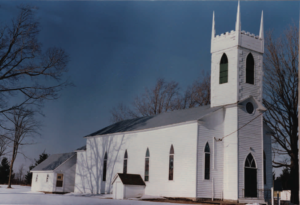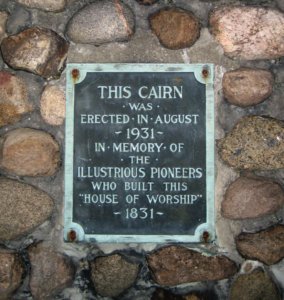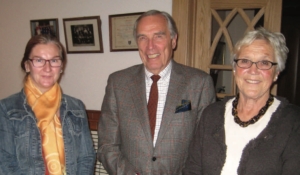Burritt's Rapids: An Historic Village on the Rideau
Presentation by Brad Smith. Article and pictures by Lucy Martin. October, 2012.

Christ Church (Anglican) in Burritts Rapids
RTHS presentations cover many topics of regional interest and are held in a number of noteworthy local venues. The Oct 17th meeting Christ Church Anglican. Built 1832 - Oldest Church in City of Ottawa in Burritt's Rapids took in yet another fine heritage building, the Anglican Christ Church.
The stately white building on Donnelly Drive overlooks the village. It was initially build in 1831 on land donated by Daniel Burritt Jr. Two additions date from 1861 and 1992. RTHS President Bill Tupper described the building's significance in last month's newsletter, in which he recalled the different ways he has interacted with “the oldest surviving church in the Rideau Valley”.
Approximately 44 members and interested area residents gathered for this talk. Tupper introduced speaker Brad Smith as a distinguished lawyer who enjoyed a career in government service followed by private practice.
Brad and Renee Smith purchased Burritt Farm in 1963 and became students and defenders of the village. Brad Smith credited his wife with being the real family expert on the community and its history. “Get the book” he quipped more than once, referring to “Burritt's Rapids 1793-1993: A Scrapbook” by Olivia Mills and Renee Smith. Indeed, a number of us did get signed copies after the talk, with proceeds from its sale going to the Burritt's Rapids community. A copy is also available at the Rideau Archives. Brad Smith called the co-authors' efforts “An example for us all of what you can do with local history – it's fascinating.”
Quoting from the book's introduction:
The Village of Burritt's Rapids is situated in the gently rolling farmland bordering the Rideau River in Eastern Ontario. It straddles the river where Colonel By, by using a natural channel, ran his canal around the small drop in the river which gives the village its name.
Controlled by a dam one half mile upstream, with its water flow also regulated by the many works higher in the canal system, the rapids of yesteryear are, save in springtime, but a pale reflection of the former self. To the tranquility of the river and the canal are added the local buildings – stone farm houses, log barns and the wood frame homes of a bygone age.
Smith described the Loyalist migration that established Upper Canada as “the flotsam and jetsam” set adrift by the America Revolution. Smith said while many of the dispossessed had been rich and powerful others were simple folk who just wanted to get on with their lives.
Historic catch phrases can summarize the spirit of an era or nation. The American credo of “life, liberty and the pursuit of happiness” followed by the French Revolution's cry of“liberté, Egalité, Fraternité” struck many Loyalists as likely routes to mob rule and violent anarchy. They preferred the goal of “peace, order and good government”.
Smith briefly detailed how events of the Revolutionary War left loyal colonials in dire need of a safe haven. One branch of the Burritt family that supported the crown saw their farm seized in Arlington, Vermont under a Court of Confiscation order in April of 1776.
After years of drama and danger as a prisoner-of-war, spy and scout for the crown, Stephen Burritt began peace-time life anew in Canada. Documents show Daniel Burritt Sr. and his son Stephen applied for Loyalist land grants in 1786-87. Stephen Burritt began with a land grant in Augusta Township. Stephen's four brothers and six sisters settled in Upper Canada as well.
Stephen Burritt established what became Burritt's Rapids (with assistance from various brothers) by building on the north side of the Rideau in 1793.
According to supplemental reference books, Stephen Burritt was awarded 200 acres at Lot 26, Concession 1 of Marlborough Township. By the end of 1773, families with nearby concessions included Ashael Hurd, William Sowles, John McNeil and Edmund Burritt. (Daniel Burritt Jr. was another early settler, though as of this writing I have not nailed down the date of his taking up residence in Burritt's Rapids.) Early settlers on the south shore as of 1805 included: Abel Adams,Alex McCrae, Helison Harris, James Lane and “one Bongard”.
Stephen Burritt's wife, Martha was the daughter of another early settler, Roger Stevens. One of Stephen and Martha's children, Edmund (b. Dec 1793) is thought to be the first white child born in the area. These pioneer families had the capacity to deal with settling new land, with all the perseverance, skill, and industry that demanded.
The mid-village island that forms the center of Burritt's Rapids was created by the construction of the Rideau Canal, which took advantage of a previous ditch. There was no bridge until the 1820's, but the site offered valuable water power. Over time the village evolved into a shape speaker Smith compared to “a tadpole with two tails”.
Settlement and the establishment of mills lead to more elements of a thriving pioneer community, such as churches, schools, hotels, stores, taverns, skilled tradesmen, a bank and doctor. By the death of Daniel Burritt Jr. in 1859 at age 87, the village of approximately 400 souls boasted those amenities and more.

Centennial cairn at Christ Church was built using stone coping from the Burritt family farm in Vermont.
At first the Rideau Canal offered new prospects for Burritt's Rapids. But not long after the canal began to stimulate more economic growth, serious competition from railroads entered the picture. Over time, rail and shipping routes along the St. Lawrence corridor became more important than the Rideau and communities along that waterway.
Industries that had been based in Burritt's Rapids faded away. A woolen mill that had employed 30 people burned in 1950. The village's only remaining store closed in the last decade. It is still instructive to look down the street and see the heritage buildings in the context of the 19th century uses. But the village is now principally residential in nature.
This story is typical of many such rural communities in this region of Ontario. Unassuming and often smaller today than in yesteryear - but built by settlers who displayed impressive determination, principles and industry. Smith says we owe their memory more recognition and respect.
After decades in Burritt's Rapids, Brad Smith reports that the small village of just several hundred residents often seems like “the uttermost part of the earth”. As the southern-most boundary of a very large municipality, Burritt's Rapids is now governed by Ottawa officials who may have scant familiarity with the village and its needs.

New village resident Jayne Molony (left) meets old-timers Brad and Renee Smith after Brad Smith's talk on the history of Burritt's Rapids.
Post-talk questions from the audience centered around the general concerns of current residents and curiosity about specific buildings. A side discussion emerged about traffic and the closure of the near-by Andrewsville Bridge. NOTE: more Information on the status of that bridge is available on-line at: https://ngtimes.ca/the-fight-to-save-the-andrewsville-bridge-continues/
There was also some discussion about what living conditions in Wales in the early 1600's may have prompted the Burritt line to move to the New World in the first place. By the way, a fulsome study of the Burritt family line in North America (1635-1940) as descended from William Burritt of Stratford, Connecticut can be found on line at: http://archive.org/details/burrittfamilyina00burr
At the conclusion of the formal presentation I met new resident of Burritt's Rapids, Jayne Molony. She and her husband arrived from Toronto in May. She says they discovered Burritts Rapids on the Internet. They came to look around and in a matter of hours they bought the house they'd come to see. She was attracted by the historic character of the picturesque village and hopes to learn more about her new home.
Asked how he first came to live in the village Brad Smith said it all began with something he spied in a newspaper when his family still lived in a stone bungalow in New Edinburgh. It was just a small ad, about a farm by the river. They went out and had a look. Smith says the place was in disrepair, so they had to think about it for a while. They decided to buy it in 1963 as a summer place. Eventually, they took the plunge and moved in year-round in 1966.
Smith says dealing with older properties takes some doing but added they'd been fortunate in having a good restoration architect and help from people who worked on Upper Canada Village. He remarked, “It was like building a new house inside four walls - an awful lot of work! It wasn't all finished and still isn't all finished.”
And how did he approach preservation with practical needs? “You have to take care of these places. But you can't become totally absorbed by them – you gotta live there, you know? You gotta be comfortable in them, with children and dogs.” Laughing, he added, “It'a a very livable house, but not in a modern sense!”
Dave Westman lives just a few kilometers from the church and heard about the talk from his neighbour. He decided to attend and bring his wall-size “Map of the United Counties of Leeds Grenville Canada West” which was dated 1861. Westman says the map came from a school in Smiths Falls before it was bought by a collector. A friend picked it up at an estate sale, before giving it to Westman.

Attendees viewing 1861 map of the "United Counties of Leeds Grenville Canada West."
Westman likes the map's many fine details, including its depiction of specific businesses that reflect prior industrial activity in the region, like “Canada Cornstarch Works, Edwardsburgh” and “Grenville Foundry, Prescott”. Westman spoke with Georgie Tupper about the prospect of having the map go to the Rideau Archives for posterity.
All in all it was a pleasant evening of “exploring” Burrit's Rapids - a charming and historic part of our regional heritage.
